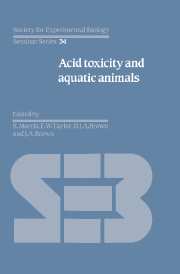Book contents
- Frontmatter
- Contents
- Contributors
- Units, Symbols and Formulae
- Preface
- Introduction: The causes and consequences of surface water acidification
- Invertebrate communities in acid streams
- Fish survival in acid waters
- Field studies on fisheries in acid waters in the UK
- Episodic changes in water quality and their effects on fish
- Acid–base regulation in fishes: 1. Mechanisms
- Acid–base regulation in fishes: 2. Biological responses and limitations
- Intracellular pH regulation and the effects of external acidification
- The physiological problems of fish in acid waters
- Laboratory studies on invertebrate survival and physiology in acid waters
- The physiological problems of crayfish in acid waters
- The effects of hydrogen and aluminium ions on fish gills
- The combined effects of pH and trace metals on fish ionoregulation
- Endocrine responses to acid stress in fish
- Commentary and conclusions
- Index
Acid–base regulation in fishes: 2. Biological responses and limitations
Published online by Cambridge University Press: 05 February 2012
- Frontmatter
- Contents
- Contributors
- Units, Symbols and Formulae
- Preface
- Introduction: The causes and consequences of surface water acidification
- Invertebrate communities in acid streams
- Fish survival in acid waters
- Field studies on fisheries in acid waters in the UK
- Episodic changes in water quality and their effects on fish
- Acid–base regulation in fishes: 1. Mechanisms
- Acid–base regulation in fishes: 2. Biological responses and limitations
- Intracellular pH regulation and the effects of external acidification
- The physiological problems of fish in acid waters
- Laboratory studies on invertebrate survival and physiology in acid waters
- The physiological problems of crayfish in acid waters
- The effects of hydrogen and aluminium ions on fish gills
- The combined effects of pH and trace metals on fish ionoregulation
- Endocrine responses to acid stress in fish
- Commentary and conclusions
- Index
Summary
Introduction
The previous chapter (Heisler, this volume) describes the physiological mechanisms responsible for acid–base regulation in fishes. This chapter follows directly from Heisler's account and describes the physiological effects of and responses to exogenous variables (temperature, oxygen and carbon dioxide levels and pH) and endogenous variables (exercise, feeding and anaemia) which affect acid–base regulation and may limit the survival of fish.
Exogenous perturbations
Temperature
(i) Physico-chemical basis Temperature affects the acid–base status of fish because it affects the chemical equilibria both of water and of the principal buffer systems of the blood and intracellular fluids. A small part of pure water is normally dissociated into H+ and OH-; at 24 °C the quantity of each is 10-7M, and the pH is 7. At 0 °C, however, dissociation is reduced so that the pH of pure water is 7.47, and at 37 °C it is 6.81. Temperature also influences the important physiological buffers to an extent dependent upon the value of ΔH° (the latent heat of ionization) for each dissociation reaction. This value for water is about 7000 cal mol-1, but varies from only about 2200 for the bicarbonate system (which has a very flat temperature response) to more than 8000 for certain protein groups (Cameron, 1984; Reeves, 1976; Reeves & Malan, 1976). An important aspect of these temperature-induced changes in acid–base status is that they determine the net charge of proteins; the net charge in turn affects many biochemical properties, especially of enzymes (Somero, 1981).
- Type
- Chapter
- Information
- Acid Toxicity and Aquatic Animals , pp. 99 - 112Publisher: Cambridge University PressPrint publication year: 1989
- 2
- Cited by



